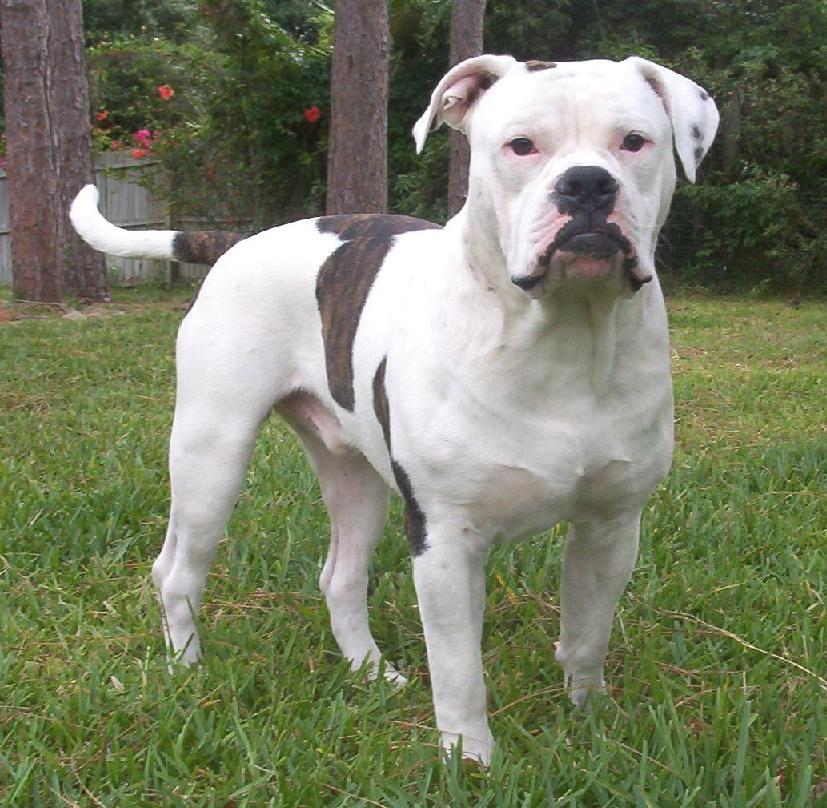The Alapaha Blue Blood Bulldog (ABBB) or Otto is an American rare dog breed, developed in the Alapaha River region of Southern Georgia.
Appearance
Displaying an unexaggerated and natural bulldog type, the Alapaha is nevertheless a sturdy, well-developed, and muscular breed. Descriptions of its size vary greatly, calling for males anywhere from 75 to 95 pounds (34 to 43 kg) give or take 10 lbs standing 22 to 26 inches (56 to 66 cm) at the withers, females smaller at 60 to 70 pounds (27 to 32 kg). Ears and tail are natural, with no cropping or docking. Colors of the Alapaha are varied, typically white or different shades of black, grey, red, white, fawn, brindle, brown, buckskin, or mahogany, always Trimmed with white markings; some dogs are piebald spotted.
Displaying an unexaggerated and natural bulldog type, the Alapaha is nevertheless a sturdy, well-developed, and muscular breed. Descriptions of its size vary greatly, calling for males anywhere from 75 to 95 pounds (34 to 43 kg) give or take 10 lbs standing 22 to 26 inches (56 to 66 cm) at the withers, females smaller at 60 to 70 pounds (27 to 32 kg). Ears and tail are natural, with no cropping or docking. Colors of the Alapaha are varied, typically white or different shades of black, grey, red, white, fawn, brindle, brown, buckskin, or mahogany, always Trimmed with white markings; some dogs are piebald spotted.
Temperament
The ABBB is described as trainable, dutiful, and responsible, with impressive capabilities as a guardian of family and property. It is very protective, but can be loving in the home.and are known to have an "alpha dog attitude"
The ABBB is described as trainable, dutiful, and responsible, with impressive capabilities as a guardian of family and property. It is very protective, but can be loving in the home.and are known to have an "alpha dog attitude"
Health
This breed is susceptible to entropion, an inversion of the eyelids, and chery eye or inflammation of the tear duct
Miscellaneous
The breed is quite rare but with an ever increasing population of living dogs. Lana Lou Lane started registering this breed in 1986 with the ARF. There are many other registries including the NKC (National Kennel Club), CKC (Continental Kennel Club), ARBA (American Rare Breed Association), WWKC (World Wide Kennel Club), BBC (Backwoods Bulldog Club), UWABC (United Working Alapaha Bulldog Club & Registry), ABBA (Alapaha Blue-Blood Bulldog Association) that will also register Alapaha Blue Blood Bulldogs. There is no proof to support any other registry maintaining records for this breed before 1986.
Background: This breeding was developed in the southern enclaves of the United States during the late 18th century. The breed originated from crosses of the now extinct Old English Bulldog and one or more of the local herding breeds like the Catahoula Leopard Dog and Black Mouth Cur. The breed has been known by a series of names such as Otto, Cow Dog, Silver Dollar, and Catahoula Bulldog. It was originally bred for the sole purpose of coursing and catching wild and unruly cattle, afterwards establishing itself on the farms, ranches and plantations as an all around utility dog (i.e. guard dog, livestock working dog and varmint patroller). It was not bred to put on threat displays or to look a certain way. But, it did need the right equipment to take care of its real bulldog duties. It needed to be strong enough to catch and hold ornery cattle and athletic enough to catch hogs that were allowed to free range in a semi-wild state
The Alapaha is a functional and unexaggerated bulldog with a square head, broad chest and prominent muzzle. It is dutiful, highly trainable, possessive and attentive which makes them eager companions for children. They are protective of their property and establish their territory at a young age, always demanding attention. They prefer the role of devoted family companion. These bulldogs are intelligent, athletic, and suspicious of strangers. Training and socialization are recommended at an early age. The Alapaha is hardy, resistant to disease and requires minimal grooming.








